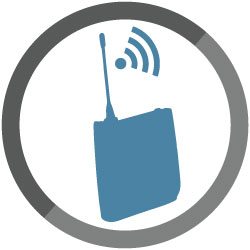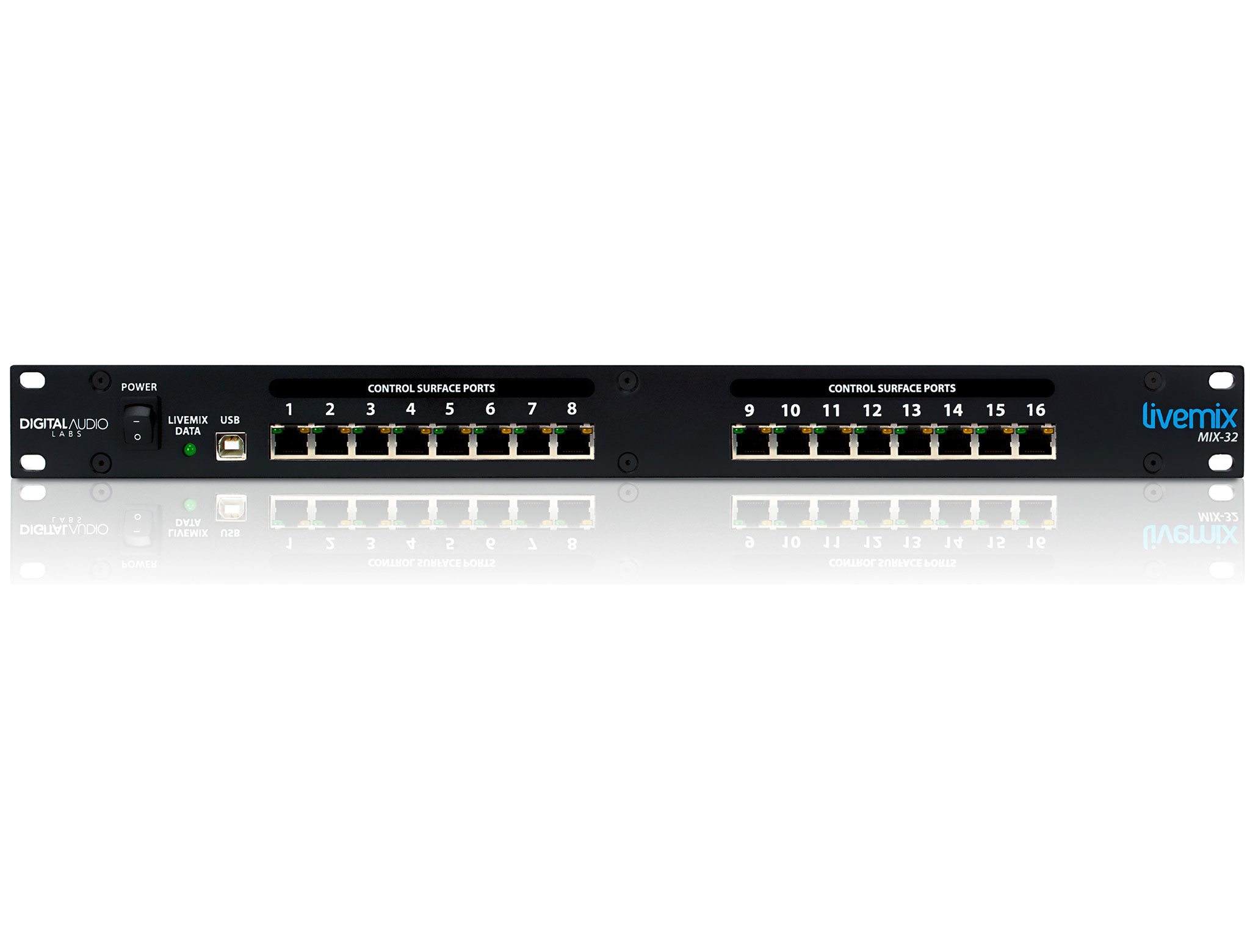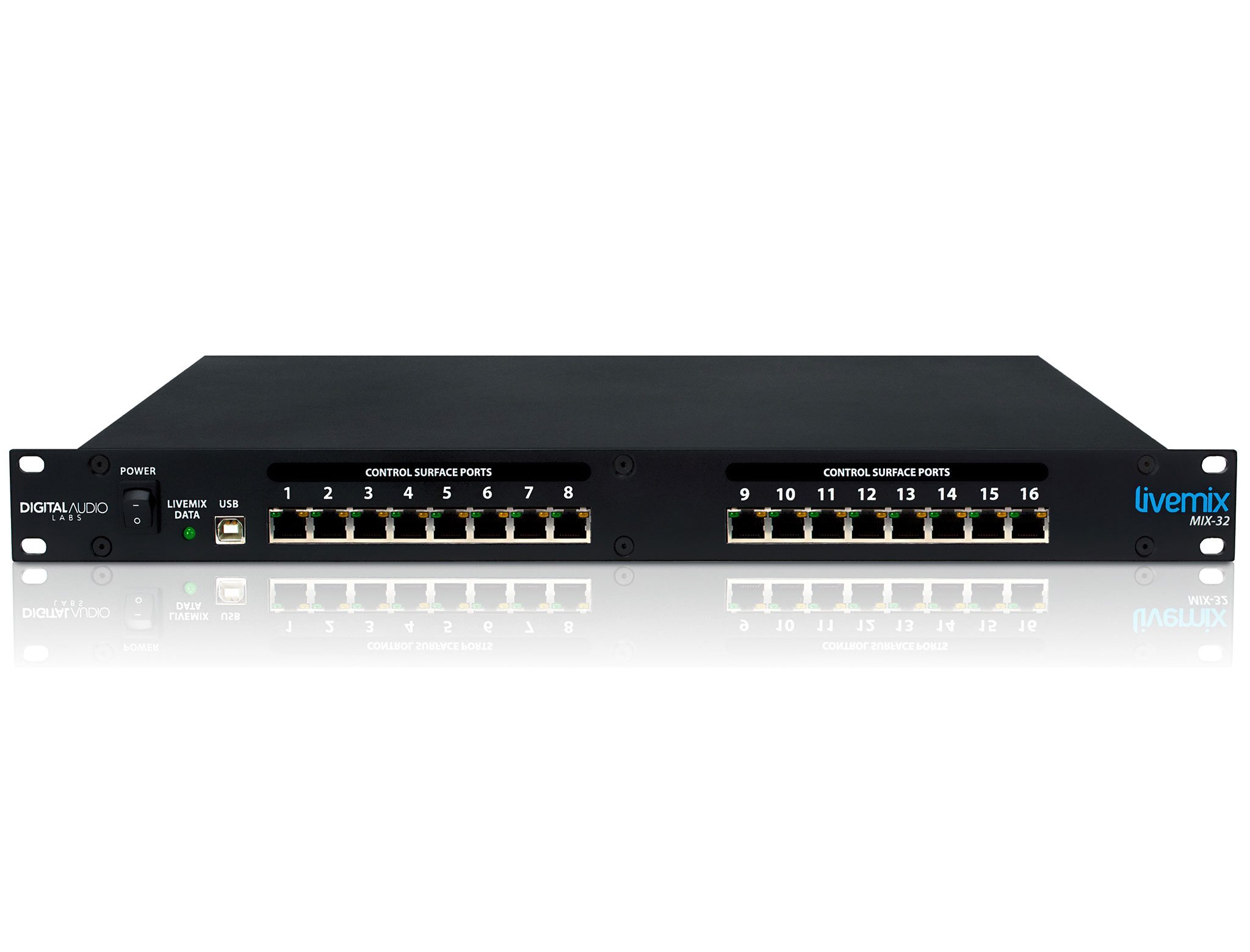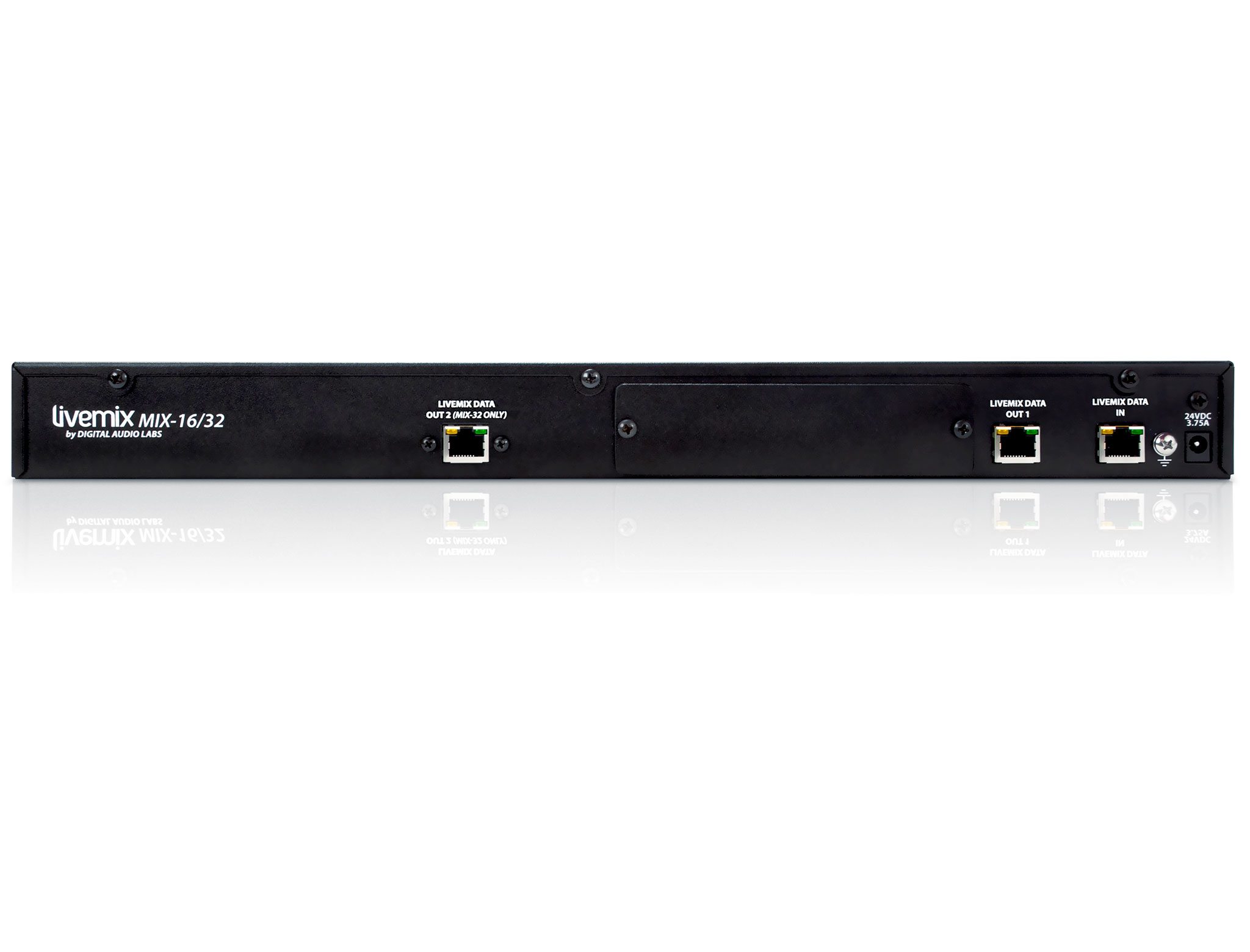The MIX-32 is the central mixer for the Livemix personal monitoring system. The MIX-32 supplies mix streams as well as power to each of the connected personal mixers.
The MIX-32 will generally be placed near the personal mixers, likely in a rack near the stage. The MIX-32 receives input data over a network cable, either from the AD-24 (shielded) or a Dante network via the LM-DANTE-EXP Dante card.
Each port on the MIX-32 supports two discrete mixes for up to 32 total mixes. Connect a single CS-DUO or up to two CS-SOLOs to each port with standard network cable. Maximum combined CAT5e cable (shielded or unshielded) distance is 100 meters.
FEATURES

24 Channel + 4 Accessory Channels
The MIX-16 receives 24 channels of audio from the AD-24 (for analog sources) or the LM-DANTE-EXP option card (for digital sources from a Dante™ Network). This is more than enough to handle the needs of church, studio, and live event stages while still being simple to use with the intuitive mix interface.

24-bit Mixing
High quality audio processing means mixes come together quicker and easier. Clear separation of instruments with no smearing and accurate sound reproduction make Livemix the best sounding personal monitor mixer on the market. Digital Audio Labs’s decades of experience in digital audio give you the very best sounding mixes possible.

Expansion Port (Option Card)
With the built-in expansion port, you never have to worry about future compatibility. The audio world is always changing and Livemix will support those changes so you can be assured that your personal monitor system will provide many years of best-in-class functionality.

Output to Analog for Transmitters
Each MIX-16 has an output port for connection to the optional Livemix DA-816 analog output unit. This lets you assign personal monitor mixes to one of 8 stereo outputs for easy wireless in-ear monitor integration.

Supports Up to 16 Personal Mixers
16 front panel ethernet ports provide power and mix capabilities to up to 32 personal monitor mixes. This can be through 16 dual mix CS-DUO units, 32 single mix CS-SOLOs or a combination.
| LIVEMIX MIX-32 | |
|---|---|
| Max Cable Length to CS-SOLO/CS-DUO |
100m CAT5e cable (shielded recommended) |
| Max Cable Length to AD-24/DA-816 |
100m CAT5e cable (shielded required) |
| Bit Rate | 24-bit Digital Mixing and Processing |
| Sample Rate | 48 kHz internal system rate Up to 96kHz sample rate input accepted from Dante network |
| Digital Format | Proprietary in system |
| Expansion | Option Card Slot |
Yes you can, and it it incredible simple. Select the channel within the group that you wish to adjust. A white border will outline the channel to indicate it is selected. LONG PRESS the ADJUST knob to temporarily remove the channel from the group. The white outline of the selected channel will flash while the channel is temporarily out of the goup. Use the ADJUST knob to adjust the volume of the channel and press the ADJUST knob to return the channel to the group.
You can connect two CS-SOLO units to a single port on the MIX-16 or MIX-32. The first mixer is the blue “A MIX” while the second unit will be the red “B MIX”. Power and audio is supplied to the second CS-SOLO over a network cable connected to the CS-SOLO THRU port. The CS-DUO must be connected directly to the MIX-16 or MIX-32.
The CS-DUO has the abiblity to link both the A and B Mixes. Select the A mix, PRESS and HOLD both Master Volume knobs at the same time. Confirm that you want to group the controls. At this point both sets of control knobs will control the mix. Repeat these steps to unlink the mixes.
The Auxiliary input is designed for an amplified signal such as what is output from a smartphone headphone output. In order to use a microphone with the Aux input, it would need to be used with a microphone preamplifier before the signal gets to the Livemix Aux in.
But as luck would have it, we make just such a device. The LM-MICPRE is a mic preamp that allows you to use a standard dynamic mic as the intercom mic. Check it out here.
While Livemix Data is transmitted over standard network cables, it is not in a format that a network can read. DO NOT use splitters, couplers, or hubs between any CS-SOLO or CS-DUO and the MIX-16/MIX-32. DO NOT connect a CS-SOLO or CS-DUO into an ethernet network. This could cause damage to the personal mixer and will void the warranty.
While Livemix Data is transmitted over standard network cables, it is not in a format that a network can read. DO NOT use splitters, couplers, or hubs between any CS-SOLO or CS-DUO and the MIX-16/MIX-32. DO NOT connect a CS-SOLO or CS-DUO into an ethernet network. This could cause damage to the personal mixer and will void the warranty.
A switch is not required for a Dante Network. You can connect the LM-DANTE card directly to the Dante output of the console. It is recommended that if you use a switch, you adhere to the Audinate requirements for a switch.
Shielded cable is required for connecting both the AD-24 and the DA-816 to the MIX-16 or MIX-32. Shielded cable is not required for connecting a CS-SOLO or CS-DUO to the MIX-16/32 or connecting the LM-DANTE card to the Dante network. However, shielded is recommended.
As of Livemix version 4.0, the Dante Controller is required for setting up Livemix on the Dante Network. Versions prior to 2.15 do not require the Dante Controller, although it’s use is recommended. You will also need to use Dante Controller to set the Master Clock for the Dante Network. See the LM-DANTE User Guide pg. 8 for assigning Dante Channels.
Digital Audio Labs has been in the audio industry for over 30 years, starting with high end sound cards in the 80’s and a full DAW system in the mid 90’s. Everyone on the Livemix design team has had extensive experience in studios, on worship teams or Front of House and Livemix is a result of that experience combined with our expertise in DSP, mixing, and amplification.
Livemix works with either analog or digital (Dante) input. With the AD-24 analog input unit you can connect TRS or DB25 connectors from your console or recording interface. For a Digital connection with Dante, plug directly into a switch. For other digital formats (MADI), you may need a format converter.
Livemix has 5 multi-channel groups, one of which is controlled with the Me Knob, and up to 12 stereo “group” links. Using this feature, you can group two channels (Stereo Keys, Guitar, Tracks) but because it only groups the volume, you can still have the ability to use the full stereo field.
Livemix has 5 multi-channel groups, one of which is controlled with the Me Knob. These groups can contain any number of channels. Livemix also supports stereo pairs. Adjacent channels can be grouped into stereo pairs for easy volume adjustments for stereo channels like keyboards and tracks.
Using MirrorMix® Remote Mixing is as easy as selecting the person you want to share with or audition, then choosing from a few options from pushing settings to remotely adjusting a mix.
We recommend to make the Master clock the console or Dante card in the console. NOTE: There are two ways this can be done. 1) Set the console’s internal clock as Master, then using Dante Controller, set the console’s Dante card as Master clock (for the Dante Network) and also check box “Sync to External”. This will allow the card to stay synched to the console’s master clock. 2) Set the console’s internal clock to be slave of the console’s Dante card. Using Dante controller, set the console’s Dante card as Master clock.
To remove the passcode, PRESS the ME Knob for three seconds on any screen that prompts you to enter the passcode. After three seconds, release the ME Knob and PRESS and hold it for three seconds more. The passcode removal screen will appear. SELECT Yes to reboot the system, removing passcode protection.
Because Livemix was designed to be volunteer friendly and easy to use, setting up effects for each channel can be done globally from one personal mixer. Setting up EQ and compression on 24 channels for every person on stage would be a nightmare (with the MIX-32 that would be 768 channels). With global effects, each channel can be optimized to fit in a mix perfectly so that each performer just needs to adjust volume and pan.
Livemix auto saves settings and mixes to a temparary location every 2 minutes. If you make an adjustment and power down without saving before it has a chance to auto save, you will lose your changes. It is recommended to always save a mix or global template when changes are made.
Through many years of working with worship teams, volunteers, and live bands, we have found that most musicians are not used to mixing multiple channels. We designed Livemix with this in mind. Additionally, it is much easier to offer help to another performer (or use MirrorMix®®) when the channels are in the same locations from personal mixer to personal mixer.
The Livemix CS-DUO is two personal mixers in one. With two mixers per unit, you can reduce stage clutter and your overall per node cost without sacrificing quality or functionality.







